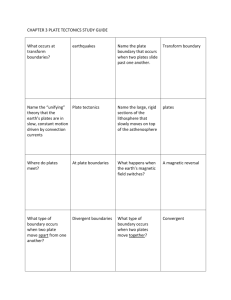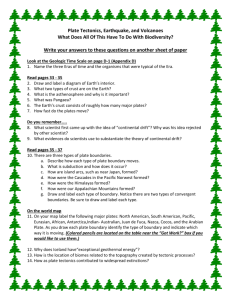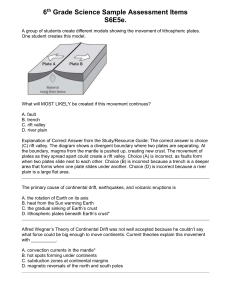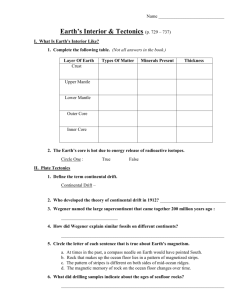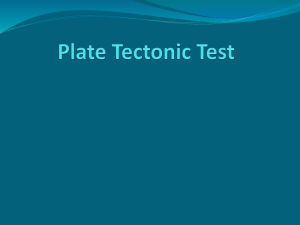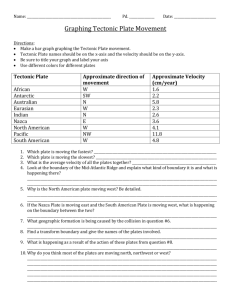Sea Floor Spreading and Plate Tectonics
advertisement
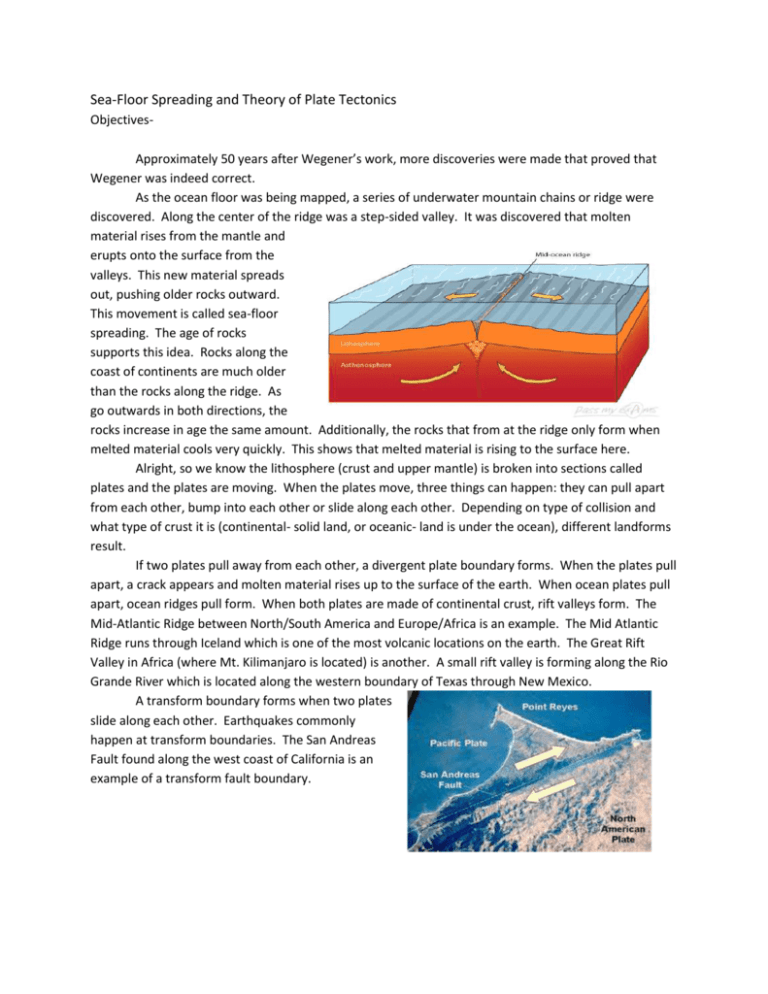
Sea-Floor Spreading and Theory of Plate Tectonics ObjectivesApproximately 50 years after Wegener’s work, more discoveries were made that proved that Wegener was indeed correct. As the ocean floor was being mapped, a series of underwater mountain chains or ridge were discovered. Along the center of the ridge was a step-sided valley. It was discovered that molten material rises from the mantle and erupts onto the surface from the valleys. This new material spreads out, pushing older rocks outward. This movement is called sea-floor spreading. The age of rocks supports this idea. Rocks along the coast of continents are much older than the rocks along the ridge. As go outwards in both directions, the rocks increase in age the same amount. Additionally, the rocks that from at the ridge only form when melted material cools very quickly. This shows that melted material is rising to the surface here. Alright, so we know the lithosphere (crust and upper mantle) is broken into sections called plates and the plates are moving. When the plates move, three things can happen: they can pull apart from each other, bump into each other or slide along each other. Depending on type of collision and what type of crust it is (continental- solid land, or oceanic- land is under the ocean), different landforms result. If two plates pull away from each other, a divergent plate boundary forms. When the plates pull apart, a crack appears and molten material rises up to the surface of the earth. When ocean plates pull apart, ocean ridges pull form. When both plates are made of continental crust, rift valleys form. The Mid-Atlantic Ridge between North/South America and Europe/Africa is an example. The Mid Atlantic Ridge runs through Iceland which is one of the most volcanic locations on the earth. The Great Rift Valley in Africa (where Mt. Kilimanjaro is located) is another. A small rift valley is forming along the Rio Grande River which is located along the western boundary of Texas through New Mexico. A transform boundary forms when two plates slide along each other. Earthquakes commonly happen at transform boundaries. The San Andreas Fault found along the west coast of California is an example of a transform fault boundary. Convergent plate boundaries form when two plates collide. When the plates are both continental plates, mountains form. Examples of this type of plate boundary include how the Appalachian and Rocky Mountains formed. The Himalayan Mts. located between Nepal and India is an active plate boundary and those mountains are still being shoved higher. As evidence that the crust was shoved this high, fossilized fish skeletons have been found high in the Himalayans. When two ocean plates converge, one plate is subducted (pushed under) the other. The one that is subducted eventually melts and the now less dense molten rock rises to the surface and forms island arc volcanoes. Japan, the Aleutian Islands between Alaska and Russia, and the US Virgin Islands all form this way. When an ocean plate and continental plate converge, a similar event happens. The ocean plate is subducted under the continental plate and creates a chain of volcanic mountains along the coast. The Andes Mountains along the west coast of South America and the Cascade Mountains along the northwest coast of the United States (includes Mt. St. Helens) form this way. Look at the plate boundary map on the next page and try to locate each of the places mentioned in the text and then use the key to see what type of plate boundary is located there. Questions Look at the map on the previous page. For each location given, tell what type of boundary is present and the landform. If possible give the specific name of the landform (ex. don’t say volcanic mountain, but Cascade Mountains). 1. Brazil (northern South America) 2. East of Saudi Arabia (Persian Gulf) 3. Hawaii (middle of Pacific Plate) 4. Philippian Islands (north of Australia) Research question: Where is the Mariana Trench located? Is it along a plate boundary? If so, what kind. How deep is the trench? 5. The process that continually adds new material to the ocean floor is called ___________________________. 6. Deep underwater canyons are called _________________________. 7. What is subduction? 8. The lithosphere is broken into separate sections called _____________________. 9. State the theory of plate tectonics. 10. Is the following sentence true or false? The theory of plate tectonics explains the formation, movement, and subduction of Earth’s plates. Matching 11. _____ plate tectonics a. deep valley that forms where two plates pull apart 12. _____ fault b. line where different pieces of the lithosphere meet 13. _____ rift valley c. break in Earth’s crust where rocks have slipped past each other 14. Compete the table. Type of Plate Boundary How Plates Move Transform boundary Divergent boundary Convergent boundary 15. Complete the table on convergent boundaries. Types of Plates Converging Ocean/ocean Ocean/continent Continent/continent Landform Feature

